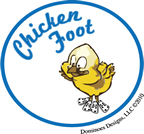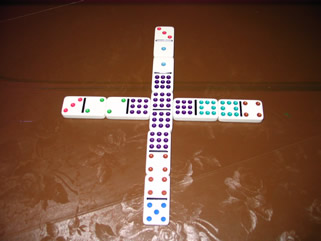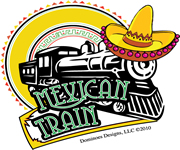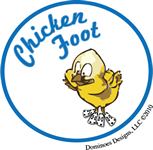The Official Wolf Lake Chicken Foot Domino Game Rules
Chicken Foot dominoes is one of the more recent versions of the Train domino family. It is also known as Chicken Dominoes, Chickie Dominoes and Chickie." The original game is said to have originated in Texas. It is very popular in the southwest and southern United States and gaining popularity in the northern states.

It is a version of Maltese Cross that is played with a double set of 6. Chicken
Foot is most commonly played with a double 9 set of 55 tiles, or sometimes
with a double 12 set of 91. The game begins in a cross format from the
opening double, so that there are initially four free ends.
The game is used widely not only for family/friendship fun but also for therapeutic and rehabilitation
purposes.
The following is a compilation of rules. As in most Train domino games there are several variations
depending on the part of the country in which you live and the individual strategies that develop over
a period of time playing.
OBJECTIVE OF THE GAME
The object of the game is to score as few points as possible by playing all your dominoes and having the lowest score at the end. Your score is counted by the number of dots on the dominoes remaining
in your hand. Chicken Foot is played in "rounds," one round for each double domino in the set.
EQUIPMENT
The game can be played with two or more players using sets of double six, double nine or double 12
dominoes. The length of the game depends on the size of the domino set used and the number of
players. Dominoes are also often referred to as bones and tiles. We will use the term "bones."
You will also need a score sheet and pencil. One person will be designated as the scorekeeper.
THE SET UP
All bones are shuffled face down. The number of bones pulled by each player depends on the number
of players. The remaining bones are left to the side and are the stock, usually called "chicken yard."
The table below determines the number of bones drawn in each hand based on the size of the
domino set and the number of players.
Number of players |
||||||
2 |
3 |
4 |
5 |
6 |
7 |
|
Domino Sets |
Number of Bones drawn per player |
|||||
Double Six |
8 |
7 |
5 |
- |
- |
- |
Double Nine |
9 |
9 |
9 |
7 |
7 |
7 |
Double Twelve |
15 |
12 |
12 |
9 |
9 |
9 |
The Play - We will assume that there are four players, playing with a double nine set – double 0 to double nine - 55 bones.
The scorekeeper will create a sheet that designates 10 rounds, nine descending to 0. At the end of a round, each player adds the spots on the bones in their hand and adds this to their score.
Points are based on:
- player who went out ...... 0 points
- other players ................. spot total
- double blank ................ 50 points
The score keeper crosses out the double that led the round and the next round begins with the highest double left. When all 10 rounds are played, the player with the lowest score wins.
Step 1
To start, the player with the double-nine plays it in the center of the play field. This double is called the “spinner.” If no player has the double-nine then the player with the next highest double plays it. The turn rotates to the left. The player to left of the first player plays any bone in their hand with a nine on it on one of the four sides of the initial bone with the nine against a free side of the double-nine.

NOTE: There is a variation with larger domino sets. A round may start with a double Chicken Foot, where three bones connect to each long edge of the starting double - two at right angles, and four at the diagonals. This is an instance where you may want to consider purchasing a hub.
Step 2
NOTE: If a player cannot play to the double, they must draw once from the chicken yard. If it plays, it can be put down immediately, otherwise he says “pass.” The next player plays another 9 on a remaining side until all four sides are filled. No other plays can be made until all four sides of the double are filled. Once all four sides are filled, the player to the left of the last person to fill the 9 may play any bone in their hand that matches an exposed end of a played bone.
If a player is unable to match any exposed bones, they must draw one bone from the chicken yard and either play it if possible or call pass. If no bones remain to draw from, the player simply calls pass.
Step 3
If a double bone is played on an exposed bone the player must declare it “Chicken Foot” or “chickie (number)". For example, if a player played a double-5 on the end of a the 4-5 domino they would lay it long- side ways- against the end with the double 5 and call "Chickie Fives.” The Chicken Foot must be filled with 3 more bones (fives) before the game may proceed elsewhere.


Step 4
When a player has one bone left, he must announce this by saying “UNO.” This is courtesy. There is no penalty.
In the second round, the play should start with the next highest unplayed double bone. The game ends when all the double bones have been played.
THE END
The game ends when one player plays his last bone or when all players have consecutively passed or the chicken yard is empty.
Strategies to Consider
Since the object of the game is to have the lowest score, it is in your best interest to get rid of your high value bones and, at the same time, prevent your opponents from playing theirs.
One strategy is to try to keep high value exposed ends covered which prevents other players from chickie-ing them.
Another strategy is to hold low value bones and try to use up a particular number for which you have a double. Once you know that there are no longer three free bones to complete the chickie, you control when the round ends by playing the chickie. This is especially good when you also have that number as your last bone.
You do want to rid yourself of the double blank since it counts as 25 points.
If you have any questions when playing or would like to share some strategies, just e-mail us at conni@dominoesdesigns .



Search Our Website
This is the descriptive text in the popup
Website Login
This is the descriptive text in the popup